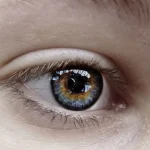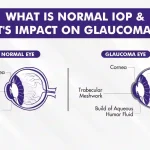Intraocular pressure (IOP) refers to the fluid pressure inside the eye. Maintaining normal intraocular pressure is essential for preserving vision and preventing serious eye conditions, like glaucoma. The eye relies on a balance between fluid production and drainage to regulate IOP. When this balance is disrupted, it can lead to increased pressure, which may contribute to optic nerve damage.
Understanding the factors that influence IOP, how it is measured, and the potential risks associated with abnormal pressure levels can help individuals take proactive steps to maintain eye health. This article explores normal intraocular pressure, the causes of fluctuations, its relationship with glaucoma, and various ways to manage eye pressure naturally and medically.
Measuring Eye Pressure
Methods Used for IOP Measurement
Eye pressure is commonly measured using tonometry, a diagnostic test performed by eye specialists. Among the methods used to assess intraocular pressure:
- Goldmann Applanation Tonometry: Considered the gold standard for measuring IOP, this technique involves applying a small amount of pressure to the cornea using a device called a tonometer.
- Non-Contact Tonometry (Air Puff Test): This is a non-invasive method uses a puff of air to measure the eye’s resistance and estimate intraocular pressure. While ideal for routine screenings, it may be followed by more precise tests if high pressure is detected.
- Rebound Tonometry: A handheld device that uses a small, lightweight probe that records pressure by making brief contact with the cornea, measuring how quickly it rebounds to calculate intraocular pressure. It is often used for children or community screenings due to its ease of use.
- Dynamic Contour Tonometry: This technique provides a more precise measurement by accounting for corneal thickness by using a specially shaped tip that closely matches the contour of the cornea.
Normal Range of Intraocular Pressure
The normal range for intraocular pressure is typically between 10 mmHg and 21 mmHg. However, some individuals may develop eye conditions even within this range, while others can tolerate higher pressures without complications and some individuals even experience optic nerve damage at normal IOP levels, a condition known as normal-tension glaucoma, making it important to have regular eye examinations for those susceptible.
Factors Affecting Eye Pressure Readings
Several factors can influence intraocular pressure readings, including:
- Time of Day: Intraocular pressure is known to follow a diurnal pattern, typically highest between 6 a.m. and 9 a.m. and gradually decreasing as the day progresses.
- Corneal Thickness: Thinner corneas may lead to underestimation of true IOP, while thicker corneas can cause overestimation.
- Age: As we age, the eye’s ability to drain intraocular fluid tends to decrease. This natural decline in drainage can cause a gradual rise in IOP, making adults over the age of 40 more susceptible to glaucoma.
- Genetics: First-degree genetics like a parent or sibling relations increase your risk of developing the condition by roughly 4 to 9 times higher than average.
- Medications: Corticosteroids (especially in eye drops, inhalers, or systemic form) are known to increase IOP by reducing the eye’s fluid outflow. Conversely, beta-blockers and prostaglandin analogues are often prescribed to lower IOP.
Causes of Eye Pressure Fluctuations
Natural Variations in IOP
It is normal for intraocular pressure to fluctuate due to natural physiological changes. These fluctuations can occur due to fluid regulation within the eye and daily activities such as blinking or body posture.
Lifestyle and Environmental Factors
Certain lifestyle choices and environmental factors can impact IOP levels, including Caffeine Consumption and Physical Activity which can both temporarily elevate IOP.
Medical Conditions That Affect Eye Pressure
Several medical conditions can lead to elevated or fluctuating intraocular pressure, including:
- Glaucoma: A disease that damages the optic nerve due to high pressure.
- Diabetes: Increased blood sugar levels may impact fluid balance in the eye.
- Hypertension: High blood pressure can contribute to elevated IOP.
Read about the Symptoms of High Eye Pressure.
Normal Intraocular Pressure and Glaucoma
Relationship Between Eye Pressure and Glaucoma
High intraocular pressure is a significant risk factor for glaucoma, a condition that leads to optic nerve damage and potential vision loss. However, glaucoma can also occur in individuals with normal IOP levels, known as normal-tension glaucoma.
Why Normal IOP Does Not Always Mean No Glaucoma
Even if eye pressure falls within the normal range, some individuals remain at risk for glaucoma due to other factors such as poor blood flow to the optic nerve, genetics, or age-related changes.
Risk Factors and Early Detection
Individuals at higher risk for glaucoma should undergo routine eye exams. Risk factors include:
- Family history of glaucoma
- Age over 40
- African, Hispanic, or Asian ethnicity
- High myopia (nearsightedness)
- Long-term corticosteroid use
How to Lower Eye Pressure
Lifestyle Changes to Help Manage IOP
Managing eye pressure naturally involves adopting a healthy lifestyle. Some recommended habits include:
- Maintaining a Healthy Diet: Foods rich in antioxidants, such as leafy greens, can support eye health.
- Hydration: Drinking sufficient water throughout the day helps regulate fluid balance in the eye.
- Proper Sleep Positioning: Sleeping with the head elevated slightly can prevent unnecessary pressure buildup.
Diet and Exercise Recommendations
- Reduce Salt Intake: High sodium levels may contribute to fluid retention, affecting eye pressure.
- Regular Exercise: Low-impact activities like walking, swimming, and yoga can promote overall eye health.
Intraocular Pressure Treatment
Medications for Controlling IOP
For individuals with elevated IOP, eye doctors may prescribe medications such as:
- Prostaglandin Analogues: Enhance fluid drainage from the eye.
- Beta-blockers: Reduce fluid production.
- Carbonic Anhydrase Inhibitors: Lower eye pressure by decreasing fluid buildup.
Surgical Options for Pressure Regulation
In cases where medication is insufficient, surgical interventions may be necessary:
- Laser Trabeculoplasty: Improves fluid drainage in the eye.
- Trabeculectomy: Creates a drainage pathway for excess fluid.
- Minimally Invasive Glaucoma Surgery (MIGS): Uses micro-implants to help regulate IOP.
When Treatment Is Necessary
Treatment is recommended when intraocular pressure poses a risk to vision, especially in individuals with a history of glaucoma or optic nerve damage.
Glaucoma Prevention and Eye Health
How to Reduce the Risk of Developing Glaucoma
- Regular Eye Exams: Early detection is key to preventing vision loss.
- Protective Eyewear: Reducing eye strain and injury can help maintain eye health.
- Following Medical Advice: Adhering to prescribed treatments can slow disease progression.
Importance of Regular Eye Checkups
Routine eye exams help monitor intraocular pressure, detect glaucoma early, and prevent complications.
Early Intervention and Protective Measures
Taking proactive steps such as wearing sunglasses, maintaining a healthy diet, and avoiding smoking can protect eye health.
Conclusion
Maintaining normal intraocular pressure is crucial for long-term eye health. Regular eye checkups, a healthy lifestyle, and early intervention can help prevent complications.
Protect your vision by keeping your eye pressure in check. Schedule an Eye Pressure Check!
FAQs
Normal intraocular pressure falls between 10 and 20 mmHg. This range is considered safe for most people. Staying within this range helps protect vision and eye health.
A pressure of 23 mmHg is considered abnormal. While not dangerously high, it could signal a risk for glaucoma. Regular check-ups can help monitor and manage this.
Eye pressure above 25 mmHg can damage the optic nerve. This can eventually lead to vision loss without treatment. Early detection through eye exams is essential to prevent this.
Normal pressure in the right and left eyes ranges from 10 to 20 mmHg. Both eyes usually maintain similar pressure levels, which helps prevent conditions like glaucoma.
People over the age of 40, those with a family history of glaucoma, individuals with high myopia (nearsightedness), diabetes, or hypertension, and long-term steroid users are considered high-risk. Ethnicity can also play a role: people of African, Hispanic, or Asian descent may be more susceptible.
While digital eye strain may cause discomfort or dry eyes, there is no strong evidence linking it directly to increased intraocular pressure. However, prolonged screen time without breaks may worsen underlying eye issues or delay detection of conditions like glaucoma.
Some FDA-approved home tonometers are available and can be helpful for ongoing monitoring, especially in high-risk patients. However, they are not a replacement for comprehensive eye exams that assess optic nerve health and visual field loss.
Yes. Intraocular pressure can rise again due to factors like medication resistance, disease progression, or changes in eye structure over time. That’s why ongoing monitoring and follow-up with your eye specialist is essential, even if your pressure is under control now.





